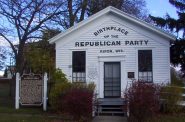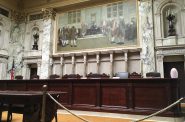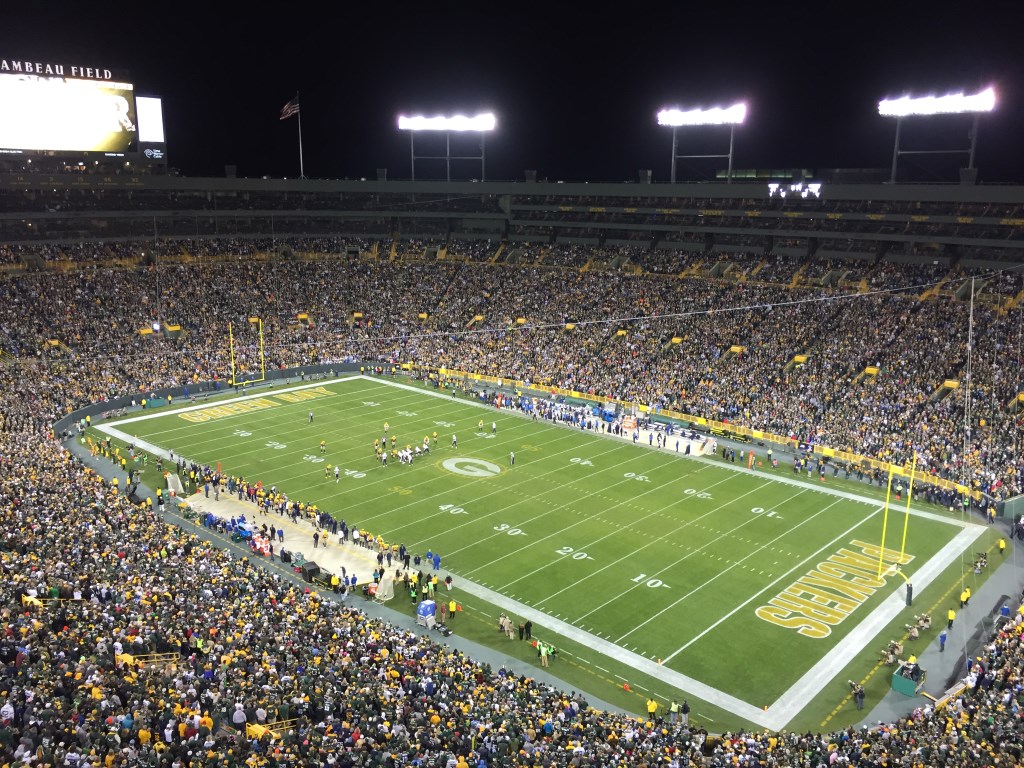A Tale of Three Sports Facilities
How the funding and politics varied for Lambeau Field, Miller Park and Bucks’ new arena.
There was a tax cut in Wisconsin on Sept. 30.
You didn’t notice?
OK, taxes were lowered in only one of state’s 72 counties – Brown County – and it was easy to miss. It had only raised the sales tax on a $10 purchase by 5-cents, after all. And, the tax increase had helped every Cheesehead’s favorite pro football team, the Green Bay Packers.
Still, the end of the 0.5 percent sales tax surtax in Brown County that remodeled Lambeau Field offers a fascinating contrast as Milwaukee-area officials negotiate the final deals to begin construction of a $500-million Bucks basketball arena downtown.
Let’s review how elected state and local leaders decided to build or remodel the homes of the state’s top three pro sports teams over the last 20 years. In the beginning was the Pack, which played its first game in Green Bay in 1919 – decades ahead of Milwaukee’s Brewers and Bucks.
Like both the 1995 deal that built Miller Park, and this year’s controversial package of $250 million in public funds to pay half of the Bucks new arena, the Lambeau Field upgrade took an act of the Legislature and approval from the governor.
But there was a big difference in the Lambeau Field deal: In a September 2000 referendum, Brown County voters agreed to raise their sales tax by 0.5 percent to pay for it. That didn’t happen in the case of the Brewers new stadium. The sales tax surtax in five counties – Milwaukee, Racine, Waukesha, Ozaukee and Washington – that built Miller Park was approved by the Legislature and then-Gov. Tommy G. Thompson in 1995.
But The Miller Park sales tax surtax is considerably lower – 0.1 percent — than the Brown County surtax. So, when you spend $10 in those five Milwaukee-area counties, 1-cent in sales tax is added for Miller Park.
Before the Bucks arena aid deal was approved, there were calls for it to go before Milwaukee County voters. But, after public opinion polls showed that it may have been defeated, no referendum was scheduled.
Nor is there a specific tax devoted to financing the arena; rather it will be built with a complex mix of funding from the state, Milwaukee County, the city of Milwaukee and the Wisconsin Center District, a special taxing district in Milwaukee County.
Besides differences in how all three pro sports projects were approved, there were also differences in the amount of public funds anted up for each.
About $259 million in bonds were issued to build Miller Park. The Journal Sentinel estimated they will cost a total of $395 million to pay off, which will not occur until sometime between 2018 and 2021.
Elected officials used 20-year payoff estimates for the $250 million in public funds to pay half of the Bucks arena. But no one knows exactly what 20 years of payments will ultimately cost state and Milwaukee city and county taxpayers.
The green-and-gold Lambeau Field subsidy was also a much more popular sell than the other two projects. The Miller Park financing package cost a Republican state senator, who changed his vote in the middle of the night to support it, his job. And the Bucks deal was not supported by all Milwaukee legislators.
Although their tax rates varied, the Lambeau Field and Miller Park surtaxes each raised more than $25 million last year, according to the Revenue Department. The Miller Park surtax brought in $28.9 million; the Lambeau Field surtax, $25.1 million.
Paying off Lambeau Field bonds left its taxing district with a surplus of more than $17 million. A bill soon to be signed into law introduced by two Green Bay legislators, Republicans Sen. Robert Cowles and Rep. David Steffen, will dictate how that excess must be distributed.
According to the bill, 25 percent of that $17 million must go to Brown County and the remaining 75 percent to cities, villages and towns in that county based on their populations. Also, the $17 million must be used for “property tax relief, tax-levy supported debt relief, or economic development.”
And how often have the Packers and Brewers won, since their new or remodeled digs were approved? Since 2001, the Packers have won 67 percent of all games; since 1996, the Brewers’ won 46 percent of their games.
The Bucks won’t tip off in their new home until 2018.
Steven Walters is a senior producer for the nonprofit public affairs channel WisconsinEye. Contact him at stevenscwalters@gmail.com
The State of Politics
-
RNC Brings Fame to Gen Z Party Leader
 Jul 15th, 2024 by Steven Walters
Jul 15th, 2024 by Steven Walters
-
Wisconsin’s Republican Roots Run Deep
 Jul 8th, 2024 by Steven Walters
Jul 8th, 2024 by Steven Walters
-
Feuding Supreme Court Justices Need a Break
 Jul 1st, 2024 by Steven Walters
Jul 1st, 2024 by Steven Walters






















So the main ideas I got from this article:
1. Wisconsinites love the Packers more than the Brewers (duh)
2. If the Miller Park tax was .5% instead of .1% it would be paid off by now (duh)
3. The bucks didn’t factor much into this article.
My understanding is the Miller Park sales tax is also funding annual maintenance and capital upgrade costs and is not limited to paying off the original bonds. Any sense of how much of the annual tax is for annual debt service versus the annual capital and maintenance?
One wonders how the Lambeau renovation would have went had this referendum happened in 1990 instead of 2000. The Packers had basically stunk for 20 years with a few bright spots. In 1995, the Brewers had basically been in pretty bad shape since the mid eighties, so, of course, it was a tough sell. Part of the Buck’s problem stems from the fact that they have not really contended since the Don Nelson days in the eighties. Also,there is the fact that the Bradley center isn’t even 30 years old. These factors could also partially explain the relative contentiousness of each deal.
This article has some factoids but skims the surface of the Bucks deal. And the lease is yet to be drafted, so who knows who much worse the deal may get for taxpayers.
But there are major differences, esp. between the Brewers and Bucks deals. The “pain” for Miller Park has been widely spread out in a .1 percent sales tax. For the Bucks arena, about 20% of the cash costs will be spread among all state taxpayers who will repay about $80 million over 20 years. Pols claim this deal is good for the state since it collects income tax from players. But local benefits of any type will be minimal, according to economists. Even so, the state expects at best to collect $300M after a total taxpayer outlay of $400M. Fuzzy math.
Another $80 million will be repaid solely by county taxpayers, a much smaller pool and one of the poorer counties in the region. Taking out $4 million a year from county coffers, however you slice it, will be quite painful for 20 years. And that does not include Chris Abele’s gift from county taxpayers to the Bucks of 10 acres of land (appraised for $9 million)–plus whatever the county pays for that site prep, which will be shared by city, county, state and Bucks owners.
Then there’s the city outlay. They’re managing to hide the “sausage” by saying most of the $47 million in borrowing will be repaid through deferred taxes (supposedly “free” tax incremental financing money–since it comes out of other tax pies). That does not count handing over a perfectly fine parking garage built with $30 million in public money, and losing its free-and-clear parking revenue. (The city will now get half of new parking revenue, after expenses. It was a deal made by the World’s Worst Negotiators. But the city will “own” the depreciating structure but not the land, which was given to the Bucks–so the city will be responsible for capital upkeep.) Oh, and the city threw in as a special bonus the former Sydney Hih lot, which the city paid $1 million to acquire.
Finally, there’s the expense to Milwaukee County/City of $93 million in borrowing (about double with deferred interest) by the Wisconsin Center District. Some will be repaid by hotel and car-rental taxes. But the real kicker is that MKE city/county residents will also pay for the Bucks arena through a half-cent food/beverage tax. No one bothered to calculate what an average city or county taxpayer might pay for the arena since the deal. That would just aggravate the pain.
The best that local residents can hope for in this arena deal is to get in on free nose-bleed tickets the Bucks give away since attendance is so lousy. Just don’t expect to run into any politicians. They’ll be schmoozing in the luxury suites.